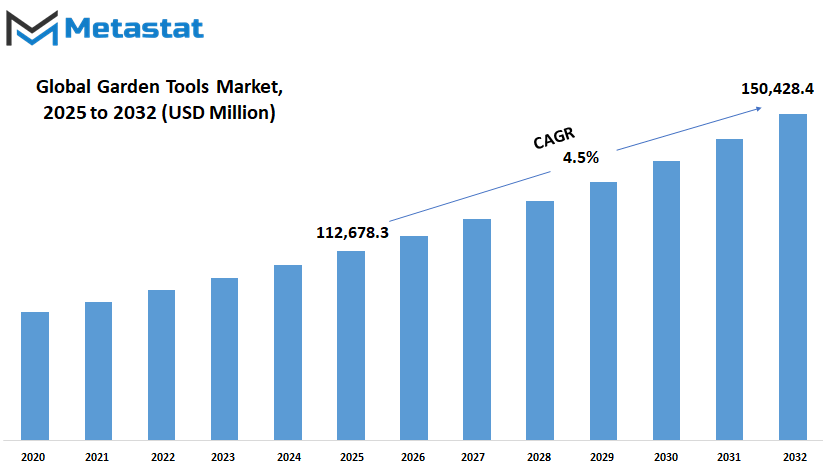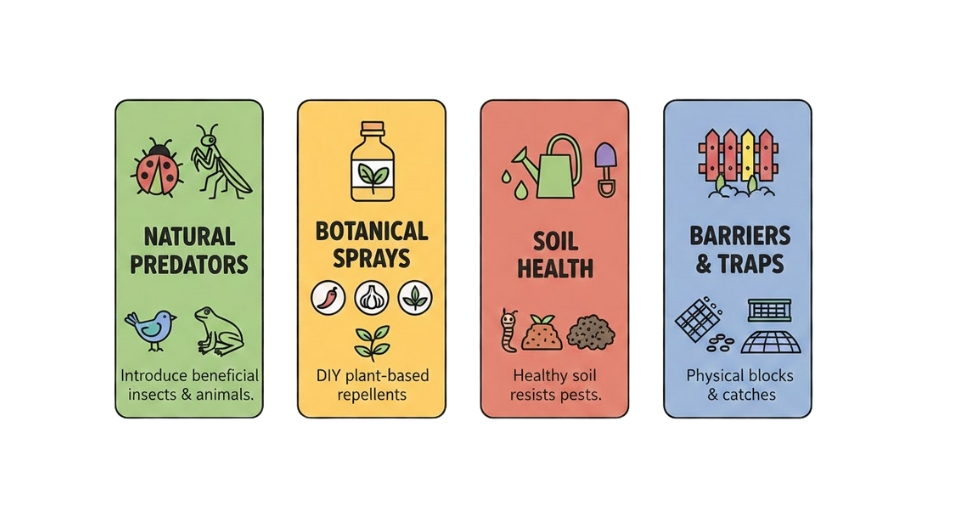MARKET OVERVIEW
The global garden tools market, a sub-segment of the wider landscaping and home improvement sector, will be a formalized system for the manufacture, distribution, and sale of equipment that is made to perform garden-related work. The market will comprise hand, electric, and battery-powered instruments produced to aid in the preparation of soil, planting, maintenance, pruning, water supply, and harvesting tasks in residential, commercial, and institutional areas. The equipment provided will vary from simple manual instruments such as trowels, forks, and pruning shears to complex motorized equipment like hedge trimmers, chainsaws, and cultivators.
What will set the global garden tools market apart is the technical accuracy and function-specific design of every product. These products will benefit not only hobby gardeners but also professional landscapers, municipal park departments, and agricultural users who need productive and long-lasting equipment. The performance, ergonomic design, and quality of material in these products will continue to be at the core of product development and customer satisfaction. Producers will have to address usage patterns that widely range by geography, climate, and cultural approaches to gardening.
The market's scope will stretch across regions where gardening is part of everyday life as either a pastime or a means of food production and environmental maintenance. For instance, urban zones with tight space will be using small and multi-purpose tools, while rural areas will require heavy-duty equipment that can manage large grounds. Seasonal changes will also impact demand patterns, along with changing lifestyles that emphasize outdoor appeal and greenery, and regulatory norms regarding noise and emissions.
Distribution and retail approaches within the global garden tools market will also change with changing lifestyles. Whereas conventional physical hardware stores and garden stores will remain relevant, digital platforms will increasingly become part of consumers' learning and buying processes regarding tools. This transition will result in more focus on virtual product demonstrations, user-generated reviews, and user-targeted gardening interest-based marketing. Subscription services and rental of gardening tools might also become attractive models in areas where temporary or communal usage is more convenient than purchasing.
From a production point of view, the global garden tools market will see a mix of players varying from local producers making artisanal tools to multinational players mass-producing a large range of items. This will add up to a mix of pricing, quality, and innovation levels. Product differentiation will be supplemented not just by technologic aspects but also by green efforts like using recyclable materials and eco-friendly manufacturing processes.
In the long run, the market will persist in extending its reach into educational, therapy, and urban planning uses. School curricula, community gardens, and wellness programs will incorporate gardening as an integral component of comprehensive well-being plans, thus broadening the customer base. global garden tools market will finally represent a synthesis of functionality, self-expression, and environmental consciousness, informing the way outdoor spaces are cultivated, maintained, and enjoyed globally and across cultures.
Global garden tools market is estimated to reach $150,428.4 Million by 2032; growing at a CAGR of 4.5% from 2025 to 2032.

GROWTH FACTORS
The global garden tools market is expected to see consistent growth as people become increasingly involved in gardening for utilitarian as well as psychological reasons. Gardening was once merely a hobby. Now, it is becoming one of the most important parts of modern living, especially with the rising demand for sustainability and eco-friendliness. People are now more aware of the benefits of growing their own vegetables, beautifying the environment with them, and dwelling in nature. These changes in lifestyle will propel the burgeoning demand for garden gear globally.
The fast-growing demand also comes as a result of increasing urban gardening and indoor greens trends. As cities expand and people live in smaller spaces, balcony, rooftop, and indoor planting has become increasingly popular. The trend will keep sales of low-maintenance, space-efficient tools going, which provides even beginning gardeners with the means to maintain healthy plants. Further, greater awareness of mental health and the therapeutic value of gardening will also push more individuals into doing this activity, further generating a demand for functional products which are easy to use. Technological innovation is yet another major driving force that will be the backbone of the growth of the market. The majority of companies are striving to come up with more intelligent tools to make gardening easier. Product features such as light weights, batteries to reduce effort, and finger grip handles are becoming common. As innovations increase, the market can anticipate tools that require less effort to operate and less risk for individuals from all ages to handle.
But the global garden tools market may face some obstacles as well. Overcharging for advanced tools may make some buyers out of their budget. Further, lack of awareness or interest in gardening in certain regions may slow down the rate of growth. Seasonal limitations in certain regions can also limit tool usage, since most of the gardening is very weather-sensitive. But there are also many chances for the market to grow in the future. As more schools, community centers, and cities adopt green projects, the need for garden equipment will rise.
Gardening education programs for children and those that advocate for home-based cultivation will create new opportunities for market growth. Additional online purchasing and home delivery options will further make it easier for more people to access quality tools, thus allowing the global garden tools market to access more people.
MARKET SEGMENTATION
By Type
The global garden tools market will continue to experience steady growth in the years to come, fueled by a combination of innovation, evolving lifestyles, and growing awareness of home renovation and eco-living. More individuals are discovering happiness and meaning in gardening, not only as a pastime activity, but as a means to connect with nature, de-stress, and produce their own food. As this trend goes on, the demand for garden tools that are simpler to use, more efficient, and even fun will only grow. Gardeners of both new and seasoned varieties want their tools to be time-and-effort-saving without compromising on quality.
Years to come will see the market place more emphasis on smart and ergonomic design. Tools that ease physical strain and allow people to work longer hours without pain will be a dominant trend. For example, better-gripped digging tools made from lightweight materials with adjustable handles can really make an impact. Shears and pruning tools will also be reengineered for precision and simplicity, particularly as gardeners learn more about how to properly care for and maintain plants. Striking tools, although utilized more in heavier gardening, will see strength and toughness improvements without undue weight additions.
Blowers and lawn mowers will get smarter. There will be more products that are battery-powered, quieter, and more efficient. This is not just a reaction to green issues but also to the convenience factor. People live in urban settings where space is at a premium, so they will seek tools that are easy to store and compact. Others in larger areas may prioritize machines that can handle wider spaces quickly and cleanly. These changes in design and function will play a big part in how the market develops.
The global garden tools market, when segmented by type, showcases a broad range of needs. Each segment, whether it's shears or blowers, has a distinct application, and as people become more discerning and knowledgeable, businesses will have to continue innovating their products. Even products that fall under the "others" category those less frequently talked about can gain acceptance if they bring something new to the table or provide a solution to issues gardeners experience.
In the future, technology and sustainability will inform product development. Products that last longer, have recyclable components, or are compatible with smart garden systems will be the winners. All of these trends indicate a larger, more conscious market informed by individuals who care about their gardens and how they maintain them.
By Operating Type
The global garden tools market is increasingly taking form to address upcoming demands, fueled by changing lifestyles as well as increased interest in home gardening. As more individuals start to consider gardening not just a need but also a means of relaxation as well as self-satisfaction, the call for improved, intelligent tools is on the rise. The market is adapting to this change, presenting numerous options appropriate for every level of experience, from novices to experienced gardeners.
The market is dominated by two primary forms of tools: manual and electric. Manual gardening tools are straightforward and long-lasting, usually used for small areas or traditional methods of gardening. They provide more control and are valued for their long lifespan. These tools have seen improvements in terms of comfort and efficiency, with designs that reduce strain on the body and materials that last longer even with regular use. However, as the interest in gardening expands, especially in urban areas, the need for quicker and less labor-intensive solutions is pushing more users toward electric gardening tools.
Electric gardening equipment introduces speed and convenience, something that is attractive to most individuals who do not necessarily have ample time available but still appreciate caring for plants. They are particularly useful in extensive spaces where hand tools would be too much to handle. These devices are also becoming intelligent, incorporating sensors, longer battery life, and improved quiet motors. Some of them are even designed with features that adapt to the user's pace and style. As technology advances further, the future will see yet more sophisticated features, possibly including application connectivity and artificial intelligence-enhanced functions, to enable users to take better care of their gardens with greater ease and efficiency.
The move toward sustainability is also a major contributor to the way that this marketplace is expanding. Most users today expect to find tools produced with environmentally friendly materials or powered by clean energy. This is forcing companies to re-evaluate their lines and also concentrate on not only performance but sustainability as well. The global garden tools market is thus not only responding to demand but also establishing new directions in the way people engage with nature.
As health, self-reliance, and greenery become increasingly in focus, the global garden tools market will continue to evolve. Whether improved manual equipment or extremely efficient electric equipment is used, the emphasis will remain on making gardening accessible, enjoyable, and compatible with living in the future.
By End Use
The global garden tools market is slowly emerging as a subject of interest since individuals increasingly focus on the way they nurture green areas. As urbanization goes on and daily life becomes more hectic, the significance of gardening, both for leisure time and for the planet, is emerging. Gardening is no longer viewed as a hobby or a means of a pastime. It's starting to play an even greater part in people's lives, reducing stress, purifying the air, and encouraging healthy lifestyles. And all this is happening quietly, affecting the future of the global garden tools market, which will keep expanding in ways we might not have yet even conceived of.
In the future, the market will be determined by how people employ garden tools, particularly if we divide it according to end use. On the one hand, we have commercial gardening equipment, commonly employed by landscaping companies, public parks, and institutions. Such equipment must be durable, efficient, and long-lasting since it is used regularly and frequently for heavy operations. As time goes by, more emphasis will be placed on making the equipment energy-efficient and lightweight. As urban areas advance towards more green environments, the demand for such instruments will increase gradually. Smart technologies may also be incorporated, like sensors to assist in checking soil or instruments that adapt themselves according to the activity.
Non-commercial gardening tools, on the other hand, are utilized by common individuals in their homes or neighborhood gardens. These tools are less complex, sometimes lighter, and meant for simplicity of use instead of heavy work. However, they are also evolving. More individuals will seek tools that are environmentally friendly, safer to handle, and even perhaps digital-friendly. For instance, a minimal gardening kit may include a partner app that provides advice on tending plants or informs you when you should water your plants. This combination of technology with gardeners' fundamental practices will create new opportunities and enable gardening to be more accessible to all age groups.
The global garden tools market will not expand simply because more people are gardening. It will expand due to the fact that how people are gardening is changing. Individuals desire tools that reflect their values, accommodate their lifestyles, and enable them to achieve more with less effort. As this occurs, the market will be redirected in new ways, influencing the way we engage with nature in our everyday life.
By Sales Channel
The global garden tools market can be anticipated to change quite dramatically in the foreseeable future, particularly if we consider how individuals are purchasing these tools. As gardening is gaining popularity for recreational purposes, self-reliance, and even safety from hunger, where and under what circumstances individuals are wanting to buy their tools will continue to transform. Garden tools today are available for purchase through a wide array of channels, with each providing its own set of benefits. They consist of Home Centers, Lawn & Garden Specialty Stores, National Retailers and Discount Stores, Hardware Stores, and E-commerce websites. Each of them has a different role to play, and their significance can vary depending upon how consumer behavior changes over time.
Home Centers are one-stop destinations. People visit them for not just garden tools but also other home improvement products. These shops will probably retain their position in the market since individuals like the convenience of having everything they need at one place. They also tend to provide good advice from employees, which is still greatly appreciated by many purchasers. Garden Specialty Stores specialize somewhat less in outdoor and gardening requirements. They serve hobbyists and professionals who desire better-quality tools and expert assistance. These stores can become more popular as gardening transitions from a hobby to an active endeavor for many.
National Retailers and Discount Stores cater to another kind of customer. These are frequently stores where individuals do their shopping for price and convenience. They are convenient and usually have seasonal displays drawing attention to gardening products during the appropriate time of year. In the years to come, such stores are bound to continue serving frugal purchasers who love to pick up tools in their routine shopping trips. Hardware Stores, on the other hand, have a utilitarian combination. They tend to have established brands and personnel who are knowledgeable about the products. They visit both new gardeners and seasoned users who like to touch and view the tools before they purchase them.
E-commerce has exhibited the steepest growth, and this is likely to persist. Online shopping is convenient, varied, and often cheaper. As delivery times improve and returns become more favorable, individuals are increasingly comfortable with purchasing tools online. It also creates room for product reviews and comparison, allowing buyers to make informed decisions. In time, E-commerce may be the most desirable method of shopping for garden tools, particularly for younger generations who are already familiar with online platforms.
As tastes change and technology continues to improve, each channel of sales in the global garden tools market will have to evolve. The secret to success down the line will be knowing customer needs and providing value through both choice and service.
|
Forecast Period |
2025-2032 |
|
Market Size in 2025 |
$112,678.3 million |
|
Market Size by 2032 |
$150,428.4 Million |
|
Growth Rate from 2025 to 2032 |
4.5% |
|
Base Year |
2024 |
|
Regions Covered |
North America, Europe, Asia-Pacific, South America, Middle East & Africa |
.
REGIONAL ANALYSIS
The global garden tools market is influenced by various regions, each playing a distinct role in the development and trajectory of the business. Such segmentation by geography enables companies to recognize where the demand is emanating from and what factors dictate customer decisions across the globe. North America, with the likes of the U.S., Canada, and Mexico, is a consistent market due to a robust home gardening culture and established retail channels. In the U.S., gardening is a hobby for many, whereas in Canada and Mexico, growing concerns about green living are contributing significantly towards heightened interest in garden upkeep.
Europe, such as the UK, Germany, France, Italy, and the rest, introduces a mix of traditional gardening practices and increasing focus on caring for the environment. In many of these regions, gardening is not only viewed as a chore, but also a means of unwinding and harmonizing with nature. The market in the future in Europe will probably be aided by the move towards green-friendly products and equipment that enhance organic cultivation practices. The area also has a very high potential for intelligent garden tools, where technology simplifies planting and maintenance.
In Asia-Pacific, including India, China, Japan, South Korea, and others, the market is transforming rapidly. Urban areas are reducing in size, yet there is a growing interest in cultivating food indoors and even on balconies. This trend is bound to continue to grow, particularly as more individuals venture into indoor and balcony gardening. China and India are set to dominate the market growth with a helping hand from increasing incomes and health as well as food quality awareness. South Korea and Japan can specialize in technology-based tools that make saving effort and time possible while still nurturing plants.
South America, Brazil, and Argentina are increasingly getting involved in this niche. There is increased interest in gardening because more individuals relocate to suburbs and seek means to enhance the living environment around their homes. In the future, demand for simple as well as sophisticated equipment might increase in this region, depending on enhanced public awareness and distribution.
In the Middle East and Africa region, comprising GCC nations, Egypt, South Africa, and others, the market for garden tools is still expanding. Although conditions are challenging due to climate, there has been an increasing trend to green cities and promote urban agriculture. All these would lead to new chances for garden tools in the coming future, particularly garden tools with speciality to function in hot and dry conditions.

COMPETITIVE PLAYERS
The global garden tools market will keep evolving as the demand for functional, effective, and environmentally friendly gardening products increases. As more individuals develop an interest in home gardening, landscaping, and city farming, this industry will steadily grow. Not only will this be driven by individual consumers, but also by commercial landscaping operations and city government initiatives. As technology continues to evolve, so will the garden equipment that is utilized, resulting in more intelligent and accurate tools that save effort and increase output.
A number of popular brands have already established themselves in this market and will have a significant hand in determining its development. John Deere, for instance, is famous for manufacturing commercial-grade tools that can cope with high-end landscaping. Honda Engines contributes its durable performance to the mix, and its users can be assured of long-term use. BOSCH and Husqvarna emphasize innovation and customer comfort, providing power tools that allow the average gardener to access them more easily. TORO and Black & Decker also bring products that find a balance between power and usability, which comforts common consumers.
MTD and Fiskars specialize in simple tools that do not involve power but are effective for simple gardening activities. Their long-standing support for manual tools will ensure that part of the market, which does not need electricity or fuel, is preserved. Oregon Tool and Emak provide products that cater to experts and repeated users, which is necessary in areas where gardening is not merely an activity but a survival need. Ariens and Victa operate in markets with different climate and terrain demands so that they can satisfy particular local requirements.
Kubota and Makita will continue to build on their image of rugged and durable machinery. STIHL with its cutting equipment and Worx with its easy-to-use designs will continue to try new things with intelligent features like battery life, noise reduction, and ergonomic construction. Each of these companies has something unique to offer, and their competition will drive the market toward the better.
In the years to come, the global garden tools market is expected to experience a combination of conventional practices and innovations. While there are users who favor basic hand tools, others will seek digital support in gardening. This blend will permit a harmonious approach, in which innovation and convention come together and address the evolving needs of individuals and their lawns.
Garden Tools Market Key Segments:
By Type
- Shears and Pruning Tools
- Striking Tools
- Digging Tools
- Blowers
- Lawn Mowers
- Others
By Operating Type
- Manual Gardening Tools
- Electric Gardening Tools
By End Use
- Commercial Gardening Tools
- Non-Commercial Gardening Tools
By Sales Channel
- Home Centers
- Lawn & Garden Specialty Stores
- National Retailers & Discount Stores
- Hardware Stores
- E-commerce
Key Global Garden Tools Industry Players
- John Deere
- Honda Engines
- BOSCH
- Husqvarna
- TORO
- Black & Decker
- MTD
- Fiskars
- Oregon Tool
- Emak
- Ariens
- Victa
- Kubota
- Makita
- STIHL
WHAT REPORT PROVIDES
- Full in-depth analysis of the parent Industry
- Important changes in market and its dynamics
- Segmentation details of the market
- Former, on-going, and projected market analysis in terms of volume and value
- Assessment of niche industry developments
- Market share analysis
- Key strategies of major players
- Emerging segments and regional growth potential








 US: +1 3023308252
US: +1 3023308252






